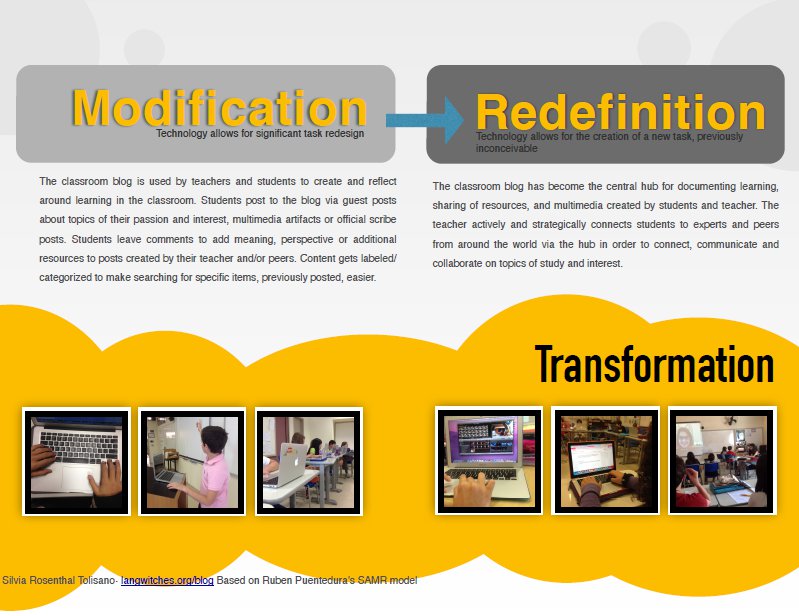Upgrading Blogs Through Lens of SAMR

The step from using a static website or emails as a mean to share announcements or calendar items to sharing the same type of items on a blogging platform is not far nor a steep step. My ultimate goal for using a classroom blog or student blogfolios though, is that of creating transformative teaching and learning opportunities, not to have a platform that substitutes a composition book or paper journal. To make the difference visible and clearer, I am looking through the lens of the SAMR model.

First, a Classroom Blog seen through the lens of SAMR


What about Student Blogs?
Substitution- technology acts as a direct substitute for the task
- A student uses the blog as a tool to substitute a handwritten/typed and printed assignment. The student copies and pastes a Google Doc or other file from a word processing program into a blog post. The comments on the blog are closed or not being utilized. Students might upload a scanned image of an analog test score, worksheet or other analog artifact. Students might answer a prompt or question posed by teacher to the entire class. There is no added value to the learning process versus the analog task.
Augmentation- technology acts as a direct tool substitution with functional improvement
- Students use their blog as a platform to publish assignments (research papers, essays, responses) for their teacher to see. The blog is a place to push out information, possibly for Student Led Conferences or a showcase/process portfolio. They insert or embed images, videos, presentations or audio to support their written text. They possibly insert hyperlinks to additional resources. Students tag and categorize their posts with searchable labels. The blog platform becomes a digital organization of students’ online learning records, which is centralized, archived and searchable. Teachers use the comment section to give feedback to their students about their performance. Classmates read each other’s papers and leave comments.
Modification- technology allows for significant task redesign
- Students use hyperlinked writing as part of digital writing process to show and connect their thinking to topics, influences, relationships and process between previously published content and external resources. Students communicate beyond the written word, in multimedia and transmedia ways. It is evident in their work that they are writing with a global audience in mind and their work encourages conversation, invites multiple perspectives to add and influence their work. Students receive constructive feedback from peers as part of the writing process. Comments inform students’ writing and original task of “paper” extends and “spills over” into the comment section, altering form of writing piece as well notion of “completion” of paper.Students are demonstrating writing skills for digital spaces, by observing digital citizenship, hyperlinked, networked, peer- connected and non- linear writing.
Redefinition- technology allows for the creation of new tasks previously inconceivable
Tools and ideas to transform education. Sign up below.
- The student blog becomes an embedded part of the process and a natural extension of communication and learning cycle by documenting evidence of learning, reflecting, sharing and receiving feedback in order to consider revision. Teachers and students actively and strategically disseminate and connect the blogs to a learning network for feedback and resources. The blog archives artifacts, reflections and connects learning over time. The blog becomes a natural extension beyond assigned academic work and is being used as a hub to document students’ learning, demonstrating self-directed and self-motivated lifelong learning habits as they are organizing, building and maintaining their own online learning records, a growing academic digital footprint and develop their personal brand as well as personal learning networks.

Silvia Tolisano is a Curriculum21 faculty member, author of the book Digital Storytelling Tools for Educators and founder of the Around the World with 80 Schools project. Read more at http://langwitches.org/blog.
